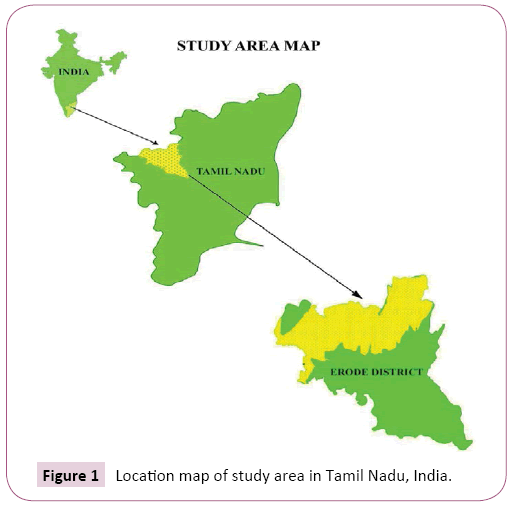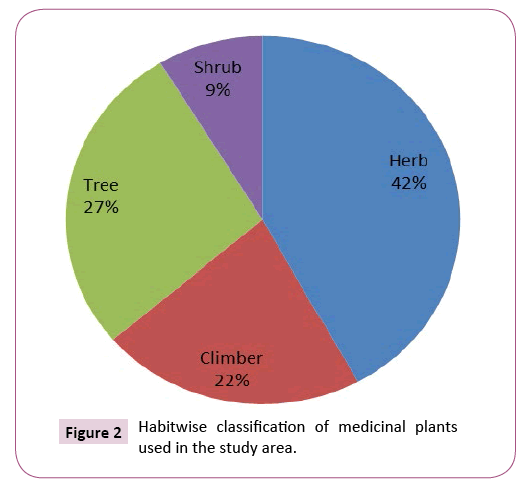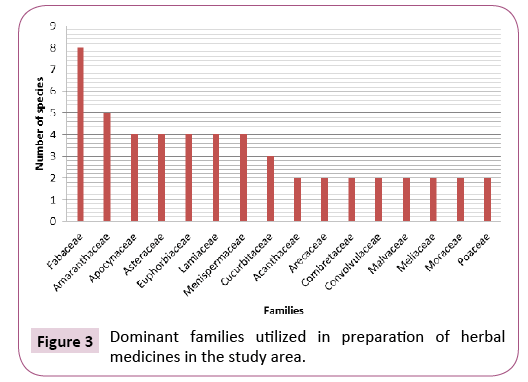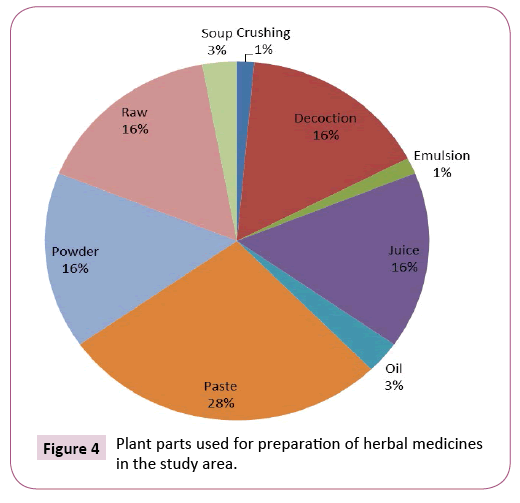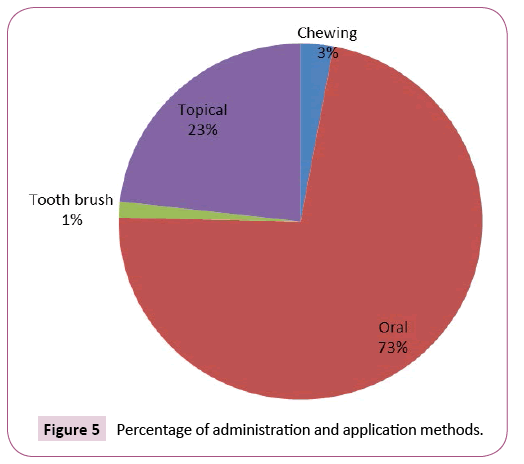ISSN : 2348-9502
American Journal of Ethnomedicine
Ethnomedicinal Plants Used by Malayali and Narikuravar Communities in Erode District, Tamil Nadu, India
Silambarasan R, Sureshkumar J and Ayyanar M*
Department of Botany and Microbiology, A.V.V.M Sri Pushpam College (Autonomous), India
- *Corresponding Author:
- Ayyanar M
Department of Botany and Microbiology
A.V.V.M Sri Pushpam College (Autonomous)
Thanjavur, India
Tel: +91 9940376005
E-mail: asmayyanar@yahoo.com
Received Date: August 31, 2017; Accepted Date: October 24, 2017; Published Date: October 31, 2017
Citation: Silambarasan R, Sureshkumar J, Ayyanar M (2017) Ethnomedicinal Plants Used by Malayali and Narikuravar Communities in Erode District, Tamil Nadu, India. Am J Ethnomed Vol.4 No.2:15
Abstract
Background: Traditional medicine plays an important role in primary healthcare of people reside in forest areas. We have reported the ethnomedicinal plants used by two ethnic communities in Western Ghats region of Erode district, Tamil Nadu, India.
Aim of study: The aim of this study is to gather ethnomedicinal information from local people and herbalists and calculate the documented information with statistical parameters.
Materials and methods: Semi structured questionnaire was used during the interview with Malayali and Narikuravar communities to document traditional knowledge on plants. The knowledge on medicinal plants used by informants to treat different types of ailments was analysed using the use value (UV) and frequency of citation (FC).
Results: A total number of 69 species of medicinal plants belonging to 33 families have been reported to treat various illnesses. Most of the plants reported in this study were used to treat diabetes, joint pain, snake bite, kidney problems, uterine disorders, sexual and fertility problems, cough, indigestion and cancer. Moringa oleifera was reported with highest UV of 5.08.
Conclusion: The present study revealed that, documentation of this knowledge will offer recognition of folk medicinal practices and could offer possible avenues for pharmacological analysis for a range of ailments. Keywords: Malayalis; Narikuravars; Ethnobotany; Tradi
Keywords
Malayalis; Narikuravars; Ethnobotany; Traditional medicine; Western Ghats
Introduction
Nature is a source of biologically active compounds and documentation on traditional medicinal plants is an important facet to reveal the past and present culture, the source of fundamental knowledge for pharmacology, sustainable use and conservation of biological resources [1]. The use of herbal remedies as an alternative to conventional medicine is becoming increasingly popular due to lesser side effects. Traditional knowledge of plants and their properties has always been transmitted from generation to generation [2]. Documentation of indigenous knowledge through field studies among tribal communities is an important factor for conservation and utilization of biological resources [3]. Many ethnic groups rely on plants collected from wild habitats for their food and primary healthcare. The plants are reported to have rich in active biomolecules, thus knowledge on plant diversity of an area and traditional uses of those plants by indigenous communities is of prime importance for development of drugs in treating a variety of ailments [4].
India is one of the twelve mega-biodiversity countries of the world having a tradition of plant-based knowledge distributed amongst a vast number of ethnic groups [5-11]. In Tamil Nadu, 36 types of tribal and local communities are resides in forests and nearby areas. There are a number of ethno botanical researches is underway in Tamil Nadu and few hill areas inhabited by indigenous communities are still not studied in ethno botanical point of view. One such forest area is forests in Erode district of Western Ghats in Tamil Nadu, India. Hence, the present study was carried out among the Malayali and Narikuravar communities and local knowledgeable persons in the Erode district to document ethno medicinal knowledge of plants used by them.
Methodology
Malayali and Narikuravar ethnic communities inhabit the surveyed villages. Most of the ethnic communities and local people in these hills are using herbal medicines with a number of plants for their primary healthcare needs. The major livelihood of these people are agriculture, cattle farming, collection of fuel-wood and forest resources viz., herbal medicines, honey, edible fruits and tubers from nearby forests. Traditional healers of these communities acquired plant based knowledge from their ancestors. Some local people are collecting plant parts from forest areas and sell them to traditional healers who are professionally practicing herbal medicine.
The population of Malayali tribals is rich when compared to Narikuravar in Erode district. The detailed facts about the Malayalis were discussed in our previous publications [12,13]. In contrast to other tribal communities, Narikuravars (or Kuruvikarar) doesn’t have particular place for their shelter and permanent hamlets. Narikuravars basically hail from a traditional hunting culture and they hunt fox, tiny wild animals and birds for their survival (www.tribalbharath.org). They live in groups, speak unique language “Vaghridholi” and find their foods from selling beads and leather made craft items. They also speak Tamil. Most of the people believe that buying fox teeth from Narikuravar will bring prosperity. They make camp tents on roadsides and under the flyovers for stay and source of livelihood. Occasionally they made a temporary settlement for staying in particular region during festivel times to sell forest resources. This community has unique customs and practices like dress habits, food habits and way of life of Narikuravar community in Tamil Nadu are different from other communities.
In order to document the utilization of medicinal plants, a methodical survey was carried out during July 2015 to August 2016 in the study area (Figure 1). During the course of time, 24 informants were identified, of which two were professional traditional healers (herbalists). Twenty two informants were local persons who had much knowledge on medicinal plants and practicing herbal medicines for their neighbourhoods. Age of the interviewed people is ranging from 31 to 72. The documented medicinal plants were collected for identification and preparation of herbarium specimens. The plant materials were preserved using standard methodologies and identified using ‘The Flora of Tamilnadu Carnatic’ [14]. APG III [15] was followed for nomenclature of plants and families. The scientific names of plant species were confirmed with the standard taxonomy database ‘Plant List’ (https://www.theplantlist.org). The voucher specimens were deposited in herbarium of A.V.V.M. Sri Pushpam College, Poondi (SPCH), Thanjavur, India for future reference.
Data associated with collected ethnomedicinal plants were sorted in MS Excel 2010 and analysed for descriptive statistical patterns viz., use value (UV) and frequency of citation. The knowledge on medicinal plants used by informants of study area to treat different types of ailments were analysed using above statistical formulae.
Use value (UV) was calculated to evaluate the comparative significance of traditional use of specific plant species by local communities [16].
UV=ΣU/n
Where, U is number of use reports cited by each informant for a given plant species and n is the total number of informants interviewed for a given plant. The UV is helpful in determining the plants with highest use in the treatment of an ailment. UVs are high when there are many use reports for a plant and low when there are few reports related to its use.
Frequency of Citation of a plant species used was done using following formula,
FC=Ni /ΣNi
Where, Ni is the number of times particular plant species was mentioned and ΣNi is the total number of times that all species were mentioned.
Results and Discussion
Medicinal plant diversity and their uses
In the present study, 69 species of medicinal plants belonging to 33 families were reported with the help of informants (Table 1). Of the reported ethnomedicinal plants, 29 species were herbs (42%) followed by trees (27%), climbers (22%) and shrubs (9%) (Figure 2). Fabaceae (8 sps.) was recorded as most dominant family (Figure 3) followed by Amaranthaceae (5 sps.), Apocynaceae, Asteraceae, Euphorbiaceae, Lamiaceae, Menispermaceae (4 sps. each), Cucurbitaceae (3 sps.), Acanthaceae, Convolvulaceae, Malvaceae, Meliaceae, Moraceae, Combretaceae and Poaceae (2 sps. each).
Table 1: List of plants used in traditional medicine by Malayali and Narikuravar communities.
| Botanical name, family, habit, availability and Voucher specimen number | Local name | FC | UV | Parts used and diseases treated | Preparation | Application |
|---|---|---|---|---|---|---|
| Abrus precatorius L., Fabaceae, Climber, SPCH-23 | Kundumni | 18 | 0.51 | Leaf - Teeth disorder | Raw | Chewing |
| Acacia nilotica(L.) Delile, Fabaceae, Tree, SPCH-29 | Karuvlam | 16 | 0.63 | Leaf - Cough; Stem - Toothache | Raw | Tooth brush |
| AcalyphaindicaL., Euphorbiaceae, Herb, SPCH-45 | Kuppaimeni | 27 | 1.31 | Leaf - Psoriasis problem | Paste | Topical |
| Acalypha alnifolia Poir., Euphorbiaceae, Herb, SPCH-14 | Kanni | 18 | 0.51 | Leaf - Poison bites | Crushing | Topical |
| AchyranthesasperaL., Amaranthaceae, Herb, SPCH-67 | Naayuruvi | 25 | 0.71 | Root - Toothache | Raw | Chewing |
| Achyranthes bidentata Blum., Amaranthaceae, Herb, SPCH-109 | Sen-naayuruvi | 24 | 1.20 | Whole plant - Kidney disease | Powder | Oral |
| Aerva lanata (L.) Juss., Amaranthaceae, Herb, SPCH-18 | Sirupoolai | 22 | 0.62 | Whole plant - Kidney problem | Powder | Oral |
| Alternanthera sessilis (L.) R. Br. ex DC., Amaranthaceae, Herb, SPCH-105 | Ponnan ganni | 22 | 0.62 | Leaf - Eye problem | Soup | Oral |
| Amaranthus viridis L., Amaranthaceae, Herb, SPCH-123 | Kuppai keerai | 21 | 0.60 | Aerial parts - Anemia | Soup | Oral |
| Andrographis echioides (L.f.) Nees., Acanthaceae, Herb, SPCH-12 | Kopuran thangi | 20 | 0.86 | Aerial parts - Snake bite | Paste | Oral |
| Andrographis serpyllifolia (Vahl.) Wight., Acanthaceae, Herb, SPCH-148 | Kattu poorankodi | 18 | 0.51 | Aerial parts - Rheumatic fever | Decoction | Oral |
| Anisomelesmalabarica(L.) R.Br. ex Sims., Lamiaceae, Herb, SPCH-58 | Peimiratti | 27 | 1.31 | Leaf - Joint pain | Paste | Topical |
| Asclepias curassavica L., Apocynaceae, Herb, SPCH-97 | Karunthuvarai | 16 | 0.46 | Whole plant - Cancer | Paste | Oral |
| ArtocarpusheterophyllusLam., Moraceae, Tree, SPCH-74 | Pala | 25 | 1.26 | Fruit - Male erectile disorder | Raw | Oral |
| Asparagus racemosusWilld., Asparagaceae, Climber, SPCH-79 | Thanner vittan kizhangu | 35 | 1.66 | Tuber - Uterine disorder | Powder | Oral |
| Azadirachtaindica A. Juss., Meliaceae, Tree, SPCH-149 | Veppilai | 35 | 2.77 | Leaf - Diabetes and chickepox | Paste | Oral |
| Azima tetracantha Lam., Salvadoraceae, Shrub, SPCH-136 | Sankilai | 24 | 0.69 | Aerial parts - Uterine disorder | Juice | Oral |
| Bacopamonnieri(L.) Wettst., Plantaginaceae, Herb, SPCH-42 | Nirbrahmi | 29 | 0.83 | Whole plant - Amnesia | Powder | Oral |
| Bambusabambos(L.) Voss, Poaceae, Shrub, SPCH-32 | Moongil | 28 | 0.80 | Seed - Joint pain | Paste | Topical |
| Bombox ceiba L., Malvaceae, Tree, SPCH-184 | Ilavam | 26 | 0.74 | Leaf - Uterine disorder | Juice | Oral |
| Boerhaviadiffusa L., Nyctanginaceae, Herb, SPCH-37 | Mukkirattai | 23 | 1.06 | Root - Psoriasis proplem | Paste | Topical |
| Borassusflabellifer L., Arecaceae, Tree, SPCH-22 | Panai | 35 | 1.66 | Fruit pulp - Sunburn | Raw | Oral |
| Butea monosperma (Lam.) Taub., Fabaceae, Tree, SPCH-192 | Karumpurasu | 27 | 1.54 | Leaf - Diabetes | Decoction | Oral |
| Calotropisgigantea (L.) Dryand., Apocynaceae, Shrub, SPCH-21 | Erukkanchedi | 32 | 1.37 | Flower - Cold | Raw | Oral |
| Camellia sinensis (L.) Kuntze., Theaceae, Tree, SPCH-197 | Theyilai | 24 | 0.69 | Leaf - Head ache | Decoction | Oral |
| Carthamus tinctorius L., Asteraceae, Herb(Purchased), SPCH-154 | Suriyagandhi | 18 | 0.51 | Seed - Heard disease | Oil | Oral |
| Cassia fistulaL., Fabaceae, Tree, SPCH-17 | Kondrai | 27 | 1.29 | Root - Snake bite | Paste | Topical |
| Caesalpinia bonduc (L.) Roxb., Fabaceae, Shrub, SPCH-212 | Kazhatchikai | 32 | 2.2 | Seed - Uterine disorder | Powder | Oral |
| CelastruspaniculatusWilld., Celastraceae, Climber, SPCH-81 | Kuvarikundal | 25 | 0.71 | Seed - Joint pain | oil | Topical |
| CinnamomumverumJ. Presl., Lauraceae, Tree, SPCH-09 | Ilavangam | 27 | 0.77 | Stem bark - Joint pain | Decoction | Oral |
| Cissampelospareira L., Menispermaceae, Climber, SPCH-36 | Vattathiruppi | 21 | 0.60 | Leaf - Leg fracture | Paste | Topical |
| Cissusquadrangularis L., Vitaceae, Climber, SPCH-32 | Pirandai | 30 | 1.49 | Stem - Stomachache and joint pain | Juice | Oral |
| Cocculushirsutus(L.) W.Theob. Menispermaceae, Climber, SPCH-39 | Kattukkodi | 17 | 0.49 | Leaf - Psoriasis proplem | Paste | Topical |
| Coix lacryma-jobi L., Poaceae, Shrub, SPCH-203 |
Kuraththipasi |
25 | 0.71 | Seed - Cancer | Paste | Oral |
| Colocasia esculenta (L.) Schott., Arecaceae, Herb, SPCH-243 | Sembu | 19 | 0.54 | Leaf - Indigestion | Juice | Oral |
| Corallocarpus epigaeus (Rottler) C.B.Clarke, Cucurbitaceae, Climbe, SPCH-169 | Agasa karudan kizhangu | 34 | 0.97 | Corm - Snake bite | Paste | Oral |
| Cullen corylifolium (L.) Medik., Fabaceae, Herb, SPCH-43 | Karpoga arisi | 26 | 0.74 | Seed - Leprosy | Paste | Topical |
| Cycleapeltata(Lam.) Hook.f. and Thomson, Menispermaceae, Climber, SPCH-83 | Appatta | 21 | 0.80 | Root - Malaria and jaundice | Decoction | Oral |
| DecalepishamiltoniiWight and Arn., Apocynaceae, Climber, SPCH-86 | Maakali kizhangu | 15 | 0.71 | Root - Psoriasis and diabetes | Paste | Oral |
| Delonixelata(L.) Gamble, Fabaceae, Tree, SPCH-30 | Vadha narayanan | 22 | 0.63 | Lf; DCS: 22 (Piles- I84) | Decoction | Oral |
| DioscoreaoppositifoliaL., Dioscoriaceae, Climber, SPCH-62 | Vaerolai valli | 21 | 0.60 | Tb; DGS: 21 (Hydrocele - N43.3) | Paste | Topical |
| Ecliptaprostrata(L.) L., Asteraceae, Herb, SPCH-64 | Karisalan kanni | 35 | 2.46 | Root – Mental disorder and eye peoblem | Juice | Oral |
| FicusreliogiosaL., Moraceae, Tree, SPCH-60 | Arasamaram | 32 | 2.17 | Fruit – Infertility | Raw | Oral |
| Heliotropiumindicum L., Boraginaceae, Herb, SPCH-28 | Theal kodukki | 35 | 1.57 | Aerial parts – Poison bites | Raw | Oral |
| Helicteres isora L., Malvaceae, Shrub, SPCH-269 | Idanjuli | 24 | 0.69 | Fruit - Earache | Emulsion | Topical |
| Indigoferatinctoria L., Fabaceae, Herb, SPCH-42 | Neeli | 15 | 0.57 | Leaf - Snake bite and leprosy | Powder | Oral |
| Ipomoea aquaticaForssk., Convolvulaceae, Climber, SPCH-53 | Thanneer keerai | 13 | 0.37 | Leaf - Sunburn | Paste | Topical |
| Ipomoea batatas(L.) Poir., Convolvulaceae, Climber, SPCH-189 | Sakkaraivalli kizhangu | 17 | 0.49 | Tuber - Ulcer problem | Raw | Oral |
| Kedrostisfoetidissima(Jacq.) Cogn., Cucurbitaceae, Climber, SPCH-51 | Appakkovai kizhangu | 26 | 1.09 | Root - Asthma and piles | Paste | Oral |
| Leucasaspera(Willd.) Link., Lamiaceae, Herb, SPCH-65 | Thumbai | 24 | 0.69 | Leaf - Cold | Juice | Oral |
| Melia dubia Cav., Meliaceae, Tree, SPCH-114 | Malaivembu | 24 | 0.68 | Leaf - Malaria | Juice | Oral |
| MomordicacharantiaL., Cucurbitaceae, Climber, SPCH-76 | Pagal | 29 | 0.83 | Fruit - Diabetes | Raw | Oral |
| MorindacitrifoliaL., Rubiaceae, Tree, SPCH-78 | Manjanaari | 23 | 0.66 | Fruit - Joint pain | Paste | Topical |
| MoringaoleiferaLam., Moringaceae, Tree,SPCH-92 | Murungai | 35 | 5.08 | Leaf and fruit - Male erectile disorder | Decoction | Oral |
| Nerium oleander L., Apocynaceae, Herb, SPCH-84 | Arali | 27 | 0.77 | Stem bark - Earache | Decoction | Topical |
| OcimumbasilicumL., Lamiaceae, Herb, SPCH-87 | Thiru neetru pachchilai | 35 | 2.54 | Leaf - Cold and cough | Juice | Oral |
| Pedalium murex L., Pedaliaceae, Herb, SPCH-57 | Yanainerunjill | 26 | 0.74 | Fruit - Kidney problem | Powder | Oral |
| Phyllanthus amarusSch. and Th., Euphorbiaceae, Herb, SPCH-02 | Keezhanelli | 32 | 0.91 | Aearil parts - Jaundice | Powder | Oral |
| Phyllanthus emblicaL., Euphorbiaceae, Tree, SPCH-146 | Nellikkani | 34 | 1.69 | Fruit rind - Diabetes | Juice | Oral |
| Piper longum L., Piperaceae, Herb (Purchased) – 113 | Vaalmilagu | 29 | 1.40 | Fruit – Nervous problems | Powder | Oral |
| Spilanthesacmella(L.) L., Asteraceae, Herb, SPCH-124 | Aangaravalli | 32 | 0.91 | Inflorescence - Toothache | Raw | Oral |
| Syzygiumcumini(L.) Skeels, Myrtaceae, Tree, SPCH-90 | Naaval maram | 33 | 0.94 | Fruit - Diabetes | Decoction | Oral |
| Terminaliaarjuna (Roxb. ex DC.) Wight and Arn., Combretaceae, Tree, SPCH-99 | Marutha maram | 25 | 0.71 | Stem bark - Heart disease | Decoction | Oral |
| Terminaliabellirica (Gaertn.) Roxb., Combretaceae, Tree, SPCH-100 | Thandrikkai | 21 | 0.60 | Fruit rind - Kidney problems | Powder | Oral |
| Tinosporacordifolia (Willd.) Miers, Menispermaceae, Climber, SPCH-10 | Seendhil kodi | 25 | 0.71 | Stem - Fever | Decoction | Oral |
| TribulusterrestrisL., Zygophyllaceae, Herb, SPCH-100 | Nerunjill | 32 | 0.91 | Fruit - Kidney problems | Powder | Oral |
| Tridaxprocumbens(L.) L., Asteraceae, Herb, SPCH-101 | Vettukkaya poondu | 25 | 0.71 | Whole plant - Injuries | Paste | Topical |
| VitexnegundoL., Lamiaceae, Tree, SPCH-132 | Nochchi | 35 | 2.14 | Leaf – Cold, cough and joint pain | Juice | Oral |
| ZingiberofficinaleRoscoe, Zingiberaceae, Herb, SPCH-108 | Inji | 26 | 1.11 | Rhizome - Indigestion | Juice | Oral |
Figure 2: Habitwise classification of medicinal plants used in the study area.
The informants in the study area were practicing 9 types of preparation to treat different ailments. Of which mostly used herbal preparation was paste (28%) followed by plant derived raw material, powder, decoction and juice (16% eah) and remaining methods like soup, crushing, oil and emulsion (with 8%) with a very few preparations (Figure 4). For some herbal medicines with bitter taste, sweet ingredients like sugar, honey, jaggery (palm sugar) or milk were added during the preparation of medicines to reduce bitterness. Various application methods were exercised by studied informants, in which oral application (73%) was most commonly used than other modes like topical (23%), chewing (3%) and used as tooth brush (1%) (Figure 5). Similarly Nadembega et al. [17], Kadir et al. [18], Mahmood et al. [19,20] and Sadeghi et al. [21] also revealed that, oral application was most frequently used administration to treat several illnesses.
Figure 5: Percentage of administration and application methods.
Quantitative analysis of data
Moringa oleifera was reported by most of interviewed informants and gives highest UV of 5.08 due to its diverse utilization among the interviewees. Majority of local people were using this plant to treat a variety of diseases mainly male erectile disorder, female infertility problems and cancer. Our previous report from Malayali tribals in Palamalai region of Tamil Nadu [13] and few more studies conferred the more or less same results [22,23].
Use value of a plant was considered based on the plant availability and accessibility and informant’s knowledge. While plants with high UV were most preferred species in study sites and plants with low UV should not be neglected as failing to mention them to future generations could increase the risk of gradual disappearance of the knowledge from a particular community [24]. The plants with low UV for the reported plants may be due to its scarce availability in studied sites [25]. The frequency of citation was used to determine local importance of each species of a study area. In the present study Moringa oleifera was recorded with highest FC which tends to show that it was locally important among all interviewed informants to treat variety of diseases like male erectile disorder, premature ejaculation, infertility problems and cancer.
Special medicines to treat specific diseases
Most of the plants reported in this study were used to treat diabetes, joint pain, snake bite, kidney problems, uterine disorders, premature ejaculation, other sexual problems, cough, indigestion and cancer. When herbalists prepare herbal preparations to treat various ailments, they frequently add some other plant parts, several ingredients and additives. Several previous studies by Ayyanar and Ignacimuthu [9], Keter and Mutiso [26], Kumar and Bharati [10] and Shah et al. [11] also supported this view.
Mixtures of several plant parts used in traditional healthcare practices were believed to exhibit synergistic interaction [27]. Apart from reported ethnomedicinal plants, informants of present study prepared fifteen types of medicines with mixture of several plant parts by means of particular names to treat specific illnesses (Table 2). Of which Aalippodi used frequently to treat various illnesses like behavioural syndromes associated with physiological disturbances and physical factors, diseases of musculo-skeletal system and connective tissues, disorder of eye and adnexa and diseases of male genital organs.
Table 2: List of plants used in mixtures to treat specific ailments in the study area.
| Major plants used for herbal preparation | Plants used in least quantity | Name of the medicine and treatment | Other ingredients used | Dosage |
|---|---|---|---|---|
| Withaniasomnifera, Asparagus racemosus, Curculigo orchioides | Piperlongum, Mucuna pruriens, Ipomoea obscura, Zingiber officinale | Veeri - Chooranam (Sexual disorders for men - paste) | Honey, milk, sugar | 5 g in early morning |
| Moringaoleifera, Ipomoea obscura | Solanum trilobatum, Amaranthus viridis, Basella alba, Cuminumcyminum | Aalippodi (Sexual disorders for men - powder) | Ghee or honey | 3-5 g in the morning for three months |
| Terminaliachebula, Ficus benghalensis | Mentha piperita | Pal - Sotthaippodi (Dental care - powder) | Salt | Brushing with the powder twice a day |
| Cocciniagrandis, Andrographispaniculata | Zingiberofficinale, Piper nigrum, Allium cepa, Allium sativum, Murraya koenigii | Vallanga rasam (Fever, cold, cough, headache - decoction) | Water | 50-100 ml taken twice a day till cure |
| Cardiospermumhalicacabum | Dodonaea viscosa, Senna occidentalis | Moottu vali thailam (Joint pain - ointment) | Gingelly oil, egg (white yolk) | 10-20 ml applied topically until cure |
| Helicteres isora | Chrysopogon zizanioides | Kaathu vali thailam (Ear pain - ointment) | Gingelly oil | 2-5 ml applied in ear before go to bed |
| Sennaauriculata, Marsdenia sylvestris, Phyllanthusemblica | Asparagus racemosus, Moringaoleifera | Sarkkarai podi (Diabetes - powder) | Milk | 2-5 g taken twice a day until cure |
| Ocimumtenuiflorum | Caesalpinia bonduc | Virai veekka thailam (Hydrocele - ointment) | Gingelly oil, egg (white yolk) | 2-5 ml applied topically during night until cure |
| Terminaliachebula, Terminaliabellirica, Phyllanthus emblica, Piper longum, Zingiberofficinale | Solanum americanum, Piper nigrum, Terminalia arjuna | Paali - Chooranam (Fertility problems in men and women, general health tonic - paste) | Milk and Honey | 2-5 g taken twice a day morning and evening (before food) |
| Andrographispaniculata | Aristolochiaindica | Vishamuri kashayam (Poison bites - decoction) | Water | 20-50 ml taken twice a day for a week |
| Allium sativum, Mimusops elengi, Caesalpinia bonduc, | Citrus limon, Mentha piperita, Moringaoleifera | Vaaivu marunthu (Gastric problems - powder) | Water, milk | 5-10 g taken twice a day for 3 days |
| Phyllanthus amarus | Ecliptaprostrata | Kaamalai podi (Jaundice - powder) | Curd | 5-10 g taken early in morning for a month |
| Acalyphaindica, Aloe vera | Pistia stratiotes | Moola thailam (Piles - ointment) |
Gingelly oil | 2-5 ml applied before go to bed |
| Azadirachta indica, Carica papaya | Cissus quadrangularis, Allium sativum | Vayitru poochi podi (Intestinal worms - powder) | Gingelly oil | 2-5 g taken before go to bed for 3 days |
| Punicagranatum, Ficus benghalensis, Moringaoleifera, Caesalpinia bonduc | Asparagus racemosus, Cuminumcyminum, Cinnamomum tamala | Karppakkuli suththi podi (Diseases of uterine and related disorders - powder) | Milk, honey | 2-10 g taken early in the morning for two months |
Conclusion
The present investigation is first report from the Western Ghats region in Erode district to quantify the medicinal plants used by tribal and local people. The results of our exploration showed that, traditional use of plants to treat various diseases in an area is based on the knowledge of people reside in those regions and diversity of medicinal plants. Majority of people in the area use wild plants for preparation of herbal medicines although some plants were purchased from nearby markets and hills. However there is a gradual loss of traditional knowledge among younger age group since lack of interest. The present study demonstrated that, traditional herbal remedies which are in current use by informants of study area need further attention on dissemination of this knowledge to next generation. Several species of documented plants were reported to have much biological actions through pharmacological studies and it revealed the importance of folk medicine in search of new biologically active compounds.
Acknowledgements
Authors are wholeheartedly acknowledges all informants in the study area who shared their knowledge on medicinal plants and their co-operation during field study. The first author (RS) is grateful to Department of Science and Technology (DST) for the award of Inspire fellowship (DST/INSPIRE/03/2014/003665) for continuation of this study.
References
- Cakilcioglu U,TurkogluI (2010) An ethnobotanical survey of medicinal plants in Sivrice (Elazıg-Turkey).J Ethnopharmacol132: 165-175.
- Kargioglu M, Cenkci S, Serteser A, Evliyaoglu N, Konuk M, et al. (2008) An ethnobotanical survey of inner-West Anatolia, Turkey. Human Ecol 36: 763-777.
- Muthu C, Ayyanar M, Raja N, Ignacimuthu S (2006) Medicinal plants used by traditional healers in Kancheepuram district of Tamil Nadu, India. J Ethnobiol Ethnomed 2: 43.
- Tuttolomondo T, Licata M, Leto C, Bonsangue G, Gargano ML, et al. (2014) Popular uses of wild plant species for medicinal purposes in the Nebrodi Regional Park (North-Eastern Sicily, Italy). J Ethnopharmacol 157: 21-37.
- Jain SK, Borthakur SK (1980) Ethnobotany of Mikiris of India. Econ Bot 34: 264-272.
- JanakiAmmal EK, Prasad PN (1984) Ethnobotanical findings on Costusspeciosus among the kanikkars of Tamil Nadu. J Econ Taxon Bot 5: 129-133.
- Jain A, Katewa SS, Chaudhary BL, Galav P (2004) Folk herbal medicines used in birth control and sexual diseases by tribals of southern Rajasthan, India. J Ethnopharmacol 90: 171-177.
- Ayyanar M, Ignacimuthu S (2005) Traditional knowledge of Kanitribals in Kouthalai of Tirunelveli hills, Tamil Nadu, India. J Ethnopharmacol 102: 246-255.
- Ayyanar M, Ignacimuthu S (2011) Ethnobotanical survey of medicinal plants commonly used by Kanitribals in Tirunelveli hills of Western Ghats, India. J Ethnopharmacol 134: 851-864.
- Kumar R, Bharati KA (2013) New claims in folk veterinary medicines from Uttar Pradesh, India. J Ethnopharmacol 146: 581-593.
- Shah A, Bharati KA, Ahmad J, Sharma MP (2015) New ethnomedicinal claims from Gujjar and Bakerwals tribes of Rajouri and Poonch districts of Jammu and Kashmir, India. J Ethnopharmacol 166: 119-128.
- Selvaraju A, Ayyanar M,Rathinakumar SS, Sekar T (2011) Plants used in ethno-veterinary medicine by Malayalitribals in Salem district of Tamil Nadu, India. Med Plants 3: 209-215.
- Silambarasan R, Ayyanar M (2015) Anethnobotanical study of medicinal plants in Palamalai region of Eastern Ghats, India. J Ethnopharmacol 172: 162-178
- Matthew KM (1983) The Flora of the Tamil Nadu Carnatic. The Rapinat Herbarium, St. Josephs College, Tiruchirapalli, India.
- Angiosperm Phylogeny Group III (2009) An update of the Angiosperm Phylogeny Group classification for the orders and families of flowering plants: APG III. Bot J Linn Soc 161: 105-121.
- Phillips O, Gentry AH, Reynel C, Wilkin P, Galvez-Durand BC (1994) Quantitative ethnobotany and Amazonian conservation. ConservBiol 8: 225-248.
- Nadembega P, Boussim JI, Nikiema JB, Poli F, Antognoni F (2011) Medicinal plans in Baskoure, Kurittenga province, Burkina Faso: An ethnobotanical study. J Ethnopharmacol 133: 378-395.
- Kadir MF, Sayeed MSB, Mia MMK (2012) Ethnopharmacological survey of medicinal plants used by indigenous and tribal people in Rangamati, Bangladesh. J Ethnopharmacol 144: 627-637.
- Mahmood A, Mahmood A, Malik RR (2012) Indigenous knowledge of medicinal plants from Leepavally, Azad Jammu and Kashmir, Pakistan. J Ethnopharmacol 143: 338-346.
- Mahmood A, Mahmood A, Malik RR, Shinwari ZK (2013) Indigenous knowledge of medicinal plants from Gujranwala district, Pakisthan. J Ethnopharmacol 148:714-723.
- Sadeghi Z, Kuhestani K, Abdollahi V, Mahmood A (2014) Ethnopharmacological studies of indigenous medicinal plants of saravan region, Baluchistan, Iran. J Ethnopharmacol 153: 111-118.
- Mutheeswaran S, Pandikumar P, Chellapandian M, Ignacimuthu S (2011) Documentation and quantitative analysis of the local knowledge on medicinal plants among traditional Siddha healers in Virudhunagardistrictof Tamil Nadu, India. J Ethnopharmacol 137: 523-533.
- Abe R, Ohtani K (2013) Anethnobotanical study of medicinal plants and traditional therapies on Batan Island, the Philippines. J Ethnopharmacol 145: 554-565.
- Chaudhary MI, He Q, Cheng YY, Xiao PG (2006) Ethnobotany of medicinal plants from Tian Mu Shan biosphere reserve, Zhejiang-province, China. Asian J Plant Sci 5: 646-653.
- Rokaya MB, Münzbergova Z, Timsina B (2010) Ethnobotanical study of medicinal plants from the Humla district of Western Nepal. J Ethnopharmacol 130: 485-504.
- KeterLK,Mutiso PC (2012) Ethnobotanical studies of medicinal plants used by Traditional Health Practitioners in the management of diabetes in Lower Eastern Province, Kenya. J Ethnopharmacol 139: 74-80.
- Guimaraes R, Barros L, Carvalho AM, Ferreira IC (2011) Infusions and decoctions of mixed herbs used in folk medicine: synergism in antioxidant potential. Phytother Res 25: 1209-1214.
Open Access Journals
- Aquaculture & Veterinary Science
- Chemistry & Chemical Sciences
- Clinical Sciences
- Engineering
- General Science
- Genetics & Molecular Biology
- Health Care & Nursing
- Immunology & Microbiology
- Materials Science
- Mathematics & Physics
- Medical Sciences
- Neurology & Psychiatry
- Oncology & Cancer Science
- Pharmaceutical Sciences
